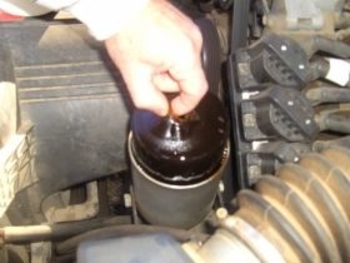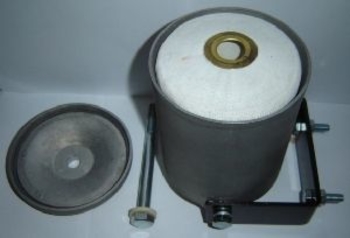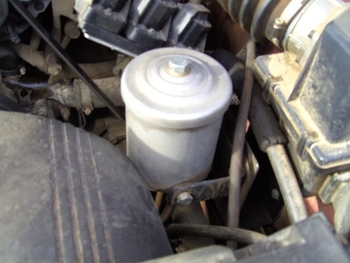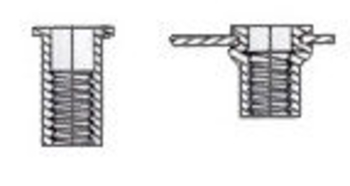Fault Finding There is not a lot that can go wrong with the Jackmaster filter. It has been designed with absolute simplicity in mind and the design has weathered many years of use in various applications. The result is that it has been found to be quite robust and trouble free. The following points are a guide to solving any problems that may emerge during the operation of the filter.
Filter Not Working If your filter is not working you should first check if the used roll displays the deep impressions formed by the bottom rack. If these are not evident then there is no downward pressure on the element.
1. Check to see if you have discarded the bottom cone seal when removing a used roll. If this is the case then oil is simply flowing from the input port across to the outlet port and you will need to replace this cone seal to seal the centre core of the element. 2. If no oil flow is exiting the filter the pressure orifice may be blocked. The element rack may have been re-installed upside down and may be blocking the outlet orifice which is only 1.5mm diameter. This is one of the good points about using the swivel return fitting in the oil filler cap. 3. The outlet orifice may be blocked by some detritus. You can blow back along the return hose with an air compressor to clear it. Just a short burst will do it. This is one of the good points about using the swivel return fitting. It is so easy to check oil flow and then so easy to blow back through the fitting without having to remove any hose connections. The design is fairly simple and easy enough to maintain. Oil Leaks. If the lid seal is leaking you may apply moderate tension to the centre bolt and this usually stops any leak. It is a square section embedded seal and can take a lot of force, however, do not overtighten as this will only cause a worn seal to distort and leak more. If the leak persists change the seal. We supply replacement seals, but if you are in a situation where you need a seal quickly, an "O" ring will do the job nicely. When using an "O" ring a lot less tension needs to be applied to the centre bolt. The sealing system for the centre bolt has been found to be the most reliable method. It is important to make sure that the steel washer on top of the rubber sealing washer is not inverted. You will notice that the edges of the steel washer are slightly rounded from being punched out during manufacture. This side of the steel washer must face the rubber seal while the flat side of the steel washer must face the bolt head. The underside of the bolt head has been machined dead flat to create a metal to metal seal against the washer.
If the centre bolt seal persists in leaking it can be replaced with a genuine Jackmaster seal or a fibre washer will work. A felt washer does a good job also. If there is weeping between the bolt head and the steel washer it may be just a simple matter of loosening the bolt and wiping the bolt head and the washer clean. That can stop the problem. Suspected blockage of the restrictor orifice.
The filter works on the principle that the unit is pressurised. Oil pressure is maintained by a 1.5mm restrictor orifice inside the base of the filter body. This restrictor is on the outlet side. Oil pressure holds the element down onto the bottom cone seal and so it is important to make sure that the correct "In" and "Out" connections have been observed. The filter rack which supports the element is removable by taking out the cone seal. This is best done by using a pair of long nosed pliers and gripping one of the segments of the filter rack. The filter rack may then be pulled up, taking the cone seal with it. If the filter is not doing its job this is one of the first things to check. Sometimes, in applications where there is a high carbon load, such as diesels (especially when using an exhaust brake), it is possible for a thick sludge to build up in the bottom of the filter canister, which is too heavy to exit the small hole, thus blocking the flow. It is a good idea to check this occasionally, especially in diesel applications. Don't assume the filter is flowing by relying on the fact that the oil filter body is getting hot when you run the engine. This is one of the main reasons to use the swivel fitting return through the oil cap. This method of return allows simple checking of the oil flow. Always push the centre of the element down tightly on the cone seal when changing the element. This was one of the reasons for adding the filter element retaining spring assembly as a spare part. By using this device, the element will be pushed tightly onto the centre cone even if you forget to do it. The spring assembly also allows the filter to work at any angle, even upside down. It also ensures that odd sized centre cores found in toilet rolls will not affect sealing to the filter base. Fittings and standards.Jackmaster supplies fittings which are purchased from manufacturers and suppliers. We endeavor to maintain a level of quality and suitability that is acceptable to use for the purpose it is supplied. It is important that we let you know that problems can arise in the use of hydraulic fittings on motor vehicles. This area is complex in its diverse use of fitting sizes and variations within standards. We know it is a real headache to go scouting for fittings and while we try to supply fittings to do the job for you it is important to remind you that you are the installer and the onus is on you to make sure the installation is good. We can advise to the best of our ability but the onus is on the installer to make sure and use due care and expertise in the installation. Ultimately the installer may have to source the occasional problem fitting. It's not all doom and gloom however and most of our customers get by with excellent installations. We are always ready to help to source that odd fitting if we can. Always screw any part into the engine by hand and check its suitability before tightening with a spanner.
|





